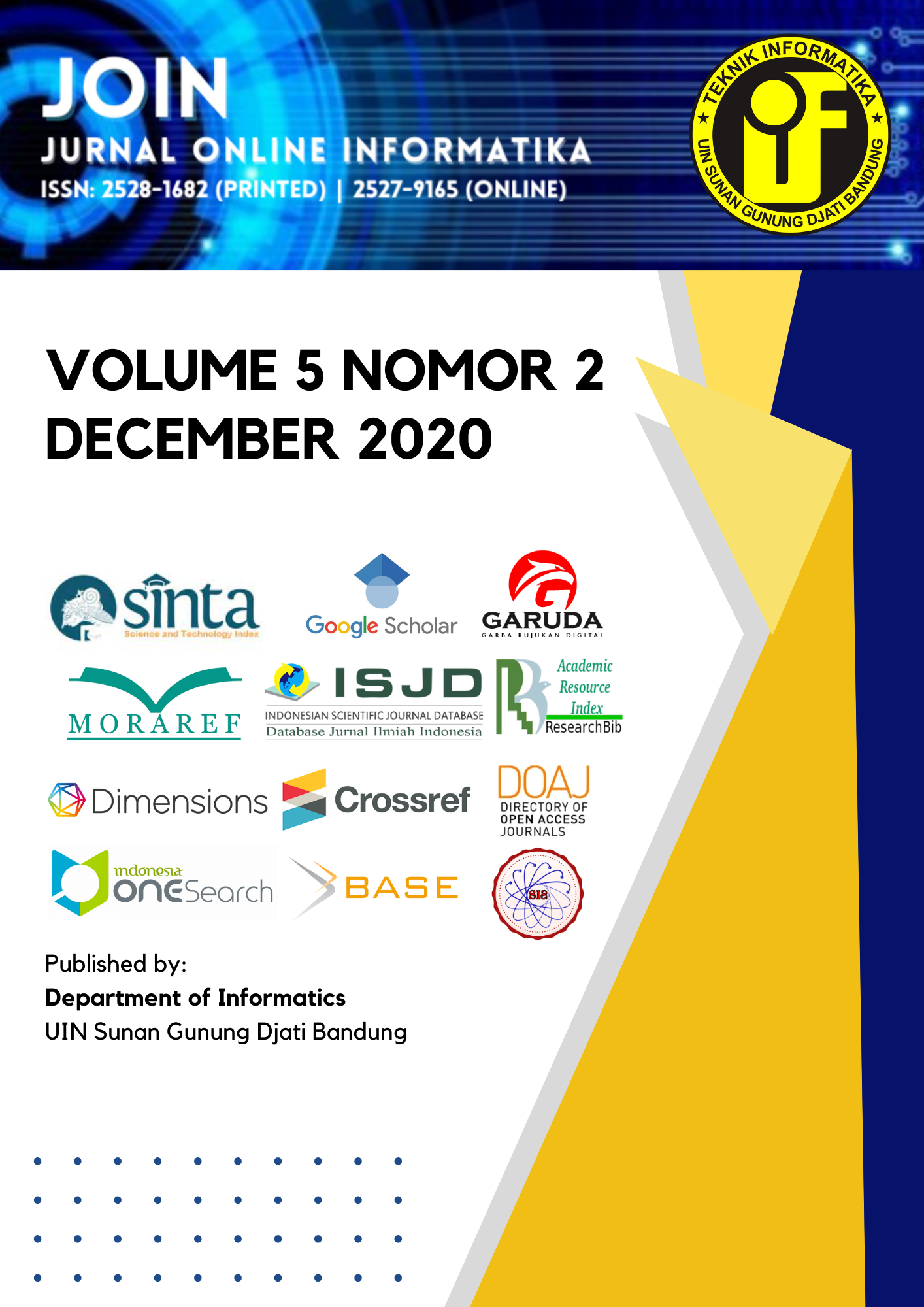Embedding a Blockchain Technology Pattern Into the QR Code for an Authentication Certificate
DOI:
https://doi.org/10.15575/join.v5i2.583Keywords:
Blockchain, QR Code, CertificateAbstract
References
Q. Aini, U. Rahardja, and A. Khoirunisa, “Blockchain Technology into Gamification on Education,†IJCCS (Indonesian J. Comput. Cybern. Syst., vol. 14, no. 2, pp. 1–10, 2020, doi: 10.22146/ijccs.53221.
U. Rahardja, S. Sudaryono, N. P. L. Santoso, A. Faturahman, and Q. Aini, “Covid-19: Digital Signature Impact on Higher Education Motivation Performance,†Int. J. Artif. Intell. Res., vol. 4, no. 1, May 2020, doi: 10.29099/ijair.v4i1.171.
J.-C. Cheng, N.-Y. Lee, C. Chi, and Y.-H. Chen, “Blockchain and smart contract for digital certificate,†in 2018 IEEE international conference on applied system invention (ICASI), 2018, pp. 1046–1051.
Q. Aini, N. Lutfiani, F. Hanafi, and U. Rahardja, “Application of Blockchain Technology for iLearning Student Assessment,†IJCCS (Indonesian J. Comput. Cybern. Syst., vol. 14, no. 2, 2020, doi: 10.22146/ijccs.53109.
F. Agustin, S. Syafnidawati, N. P. Lestari Santoso, and O. G. Amrikhasanah, “Blockchain-based Decentralized Distribution Management in E-Journals,†Aptisi Trans. Manag., vol. 4, no. 2, pp. 107–113, 2020.
P. A. Sunarya, U. Rahardja, L. Sunarya, and M. Hardini, “The Role Of Blockchain As A Security Support For Student Profiles In Technology Education Systems,†InfoTekJar J. Nas. Inform. dan Teknol. Jar., vol. 4, no. 2, pp. 13–17, 2020.
H. Bhanushali, A. Arthena, S. Bhadra, and J. Talukdar, “Digital Certificates Using Blockchain: An Overview,†in 2nd International Conference on Advances in Science & Technology (ICAST), 2019.
Q. Aini, U. Rahardja, and D. L. Nurani, “Penerapan Mata Uang Armo (AirzonE-Mall Money) Pada Marketplace AirzonE-Mall Sebagai Inovasi Pembelajaran Internet dan E-commerce,†Technomedia J., vol. 1, no. 1, pp. 114–125, 2016.
J. Umeh, “Blockchain double bubble or double trouble?,†Itnow, vol. 58, no. 1, pp. 58–61, 2016.
G. Chen, B. Xu, M. Lu, and N.-S. Chen, “Exploring blockchain technology and its potential applications for education,†Smart Learn. Environ., vol. 5, no. 1, p. 1, 2018.
G. Di Battista, V. Di Donato, M. Patrignani, M. Pizzonia, V. Roselli, and R. Tamassia, “Bitconeview: visualization of flows in the bitcoin transaction graph,†in 2015 IEEE Symposium on Visualization for Cyber Security (VizSec), 2015, pp. 1–8.
G. D. Putra, S. Sumaryono, and W. Widyawan, “Rancang Bangun Identity and Access Management IoT Berbasis KSI dan Permissioned Blockchain,†J. Nas. Tek. Elektro dan Teknol. Inf., vol. 7, no. 4, pp. 384–390, 2018.
D. Yulianto and H. Yuliansyah, “Rancang Bangun Aplikasi Traffic Counter RFID,†J. Nas. Tek. Elektro dan Teknol. Inf., vol. 4, no. 1, pp. 32–38, 2015.
C. D. Munthe and M. P. S. Hutagalung, “PEMBANGUNAN SISTEM E-VOTING MENGGUNAKAN TEKNOLOGI BLOCKCHAIN (STUDI KASUS: IT DEL).†PROGRAM STUDI DIII TEKNIK INFORMATIKA, 2019.
R. Sriwiji, “Studi Empiris Pada Pemodelan Dan Prediksi Harga Bitcoin berdasarkan Informasi Blockchain Menggunakan Bayesian Regularization Neural Network,†2019.
I. B. P. Bhiantara, “Teknologi Blockchain Cryptocurrency Di Era Revolusi Digital,†in Seminar Nasional Pendidikan Teknik Informatika (SENAPATI), 2018, vol. 9, pp. 173–177.
R. C. Noorsanti, H. Yulianton, and K. Hadiono, “Blockchain-Teknologi Mata Uang Kripto (Crypto Currency),†2018.
E. Ardhianto and N. Wakhidah, “Pengembangan Metode Otentikasi Keaslian Ijasah dengan Memanfaatkan Gambar QR Code,†J. Transform., vol. 13, no. 2, pp. 35–41, 2016.
A. C. Nugraha, “Penerapan Teknologi Blockchain dalam Lingkungan Pendidikan,†Produktif J. Ilm. Pendidik. Teknol. Inf., vol. 4, no. 1, pp. 15–20, 2020.
M. N. Ubaka-Okoye, A. A. Azeta, A. A. Oni, H. I. Okagbue, O. S. Nicholas-Omoregbe, and F. Chidozie, “Blockchain Framework for Securing E-Learning System,†Institutions, vol. 27, p. 28.
Downloads
Published
Issue
Section
Citation Check
License
You are free to:
- Share — copy and redistribute the material in any medium or format for any purpose, even commercially.
- The licensor cannot revoke these freedoms as long as you follow the license terms.
Under the following terms:
-
Attribution — You must give appropriate credit, provide a link to the license, and indicate if changes were made. You may do so in any reasonable manner, but not in any way that suggests the licensor endorses you or your use.
-
NoDerivatives — If you remix, transform, or build upon the material, you may not distribute the modified material.
-
No additional restrictions — You may not apply legal terms or technological measures that legally restrict others from doing anything the license permits.
Notices:
- You do not have to comply with the license for elements of the material in the public domain or where your use is permitted by an applicable exception or limitation.
- No warranties are given. The license may not give you all of the permissions necessary for your intended use. For example, other rights such as publicity, privacy, or moral rights may limit how you use the material.

This work is licensed under a Creative Commons Attribution-NoDerivatives 4.0 International License










